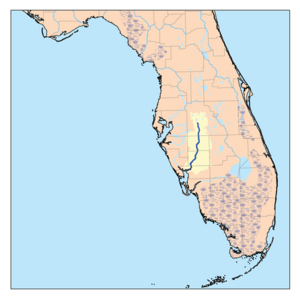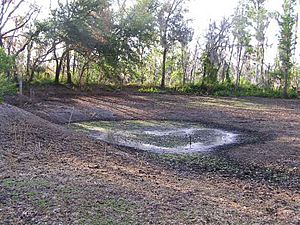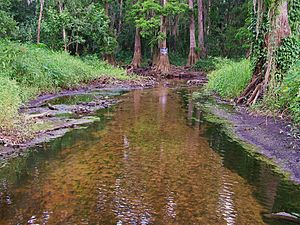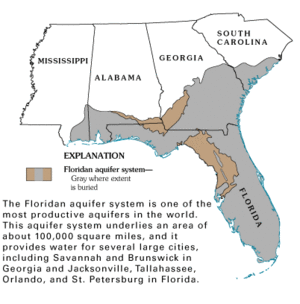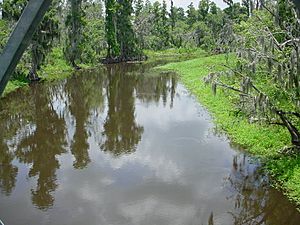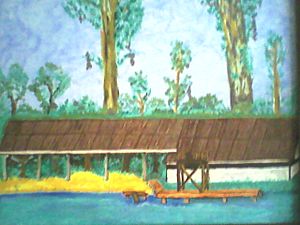Kissingen Springs facts for kids
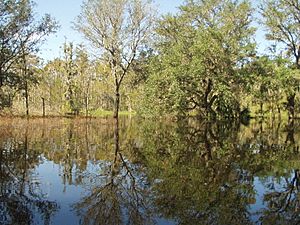
Kissingen Spring (sometimes spelled Kissengen) was a natural spring in Polk County, Southwest Florida. It was a popular place for fun activities until it dried up in 1950. Many wells drilled deep into the ground might have caused the spring to disappear. The spring's location is near the northern part of Peace River. It is about three-quarters of a mile east of U.S. Highway 17. It is also about four miles south of Florida SR 60, south of Bartow.
Contents
History of Kissingen Spring
Kissingen Spring's water came from a large underground water source called the Floridan Aquifer. It used to flow out at a rate of 20 million gallons every day. This made Kissingen Spring a very strong "second magnitude" spring.
In 1886, the Burr family moved close to the spring to start a farm.
Starting in the late 1930s, people began taking a lot more water from underground. This caused the water level in the aquifers to drop. Because of this, Kissingen Spring slowly stopped flowing. By 1950, it was officially announced that the spring was no longer active. This was due to too much water being pumped out.
Before 1950, many visitors came to the area. They enjoyed picnics, boating, and swimming. There was even a special building for parties and dancing. People also believed the spring's waters could help with different health problems.
In 1962, a sinkhole formed and filled the spring's opening with clay.
Remembering the Spring
A special historical marker was created to remember Kissingen Spring. The Florida Humanities Council helped pay for it. The Polk County Museum held a ceremony for the marker in August 2011. You can now find this marker at the Mosaic Peace River Park.
How Water Works (Hydrology)
In 1962, a sinkhole opened up near Kissingen Spring. A lot of clay flowed into the spring's opening. This clay likely blocked the underground water paths. This blockage makes it hard to bring the spring back to life.
Florida's Underground Water
Most spring water comes from a huge underground water supply. This supply is called the Floridan Aquifer. Water enters this aquifer from places where rain soaks into the ground. These areas include the Lake Wales Ridge and other old island areas to the east and north. The water in the aquifer is under pressure. This pressure pushes the water out through spring openings.
Peace River's Connection
Kissingen Spring used to send about 20 million gallons (75,700 cubic meters) of water into the Peace River. This meant the river always had water flowing in it. When the spring's water pressure dropped, large holes in the riverbed started to pull water into the ground. This reversed the flow. Water now flows into these openings, which lead to underground karst tunnels.
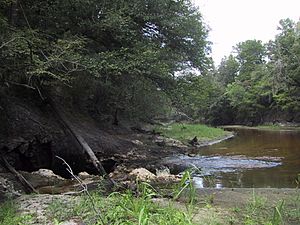
Scientists are working to control how much water drains from the aquifer.
The Peace River has many cracks and sinkholes. Water flows down into huge underground caves. These caves can hold millions of gallons of water.
A report about the Peace River talks about efforts to fix the problems. These problems were caused by the lower water levels in the Floridan Aquifer.
Peace Creek
Peace Creek is located in Polk County. It joins with Saddle Creek to form the beginning of the Peace River. This stream and the land around it have been changed from their natural state.
Bringing the Spring Back (Restoration)
It's not fully known if the water shortage at Kissingen Spring is permanent. It might be due to a period of less rain. It could also be from many years of pumping too much water from the aquifer. This happened before rules were put in place to control water use.
There is a plan to raise the water level of Lake Hancock. This would send more water towards the Peace River.
To bring Kissingen Spring back, the aquifer needs to be refilled with enough water. This would bring back the original pressure of the spring. The Peace River also needs to have a steady flow of water all year. During May, much of the upper Peace River dries up. This dry period makes it harder for the aquifer to refill. It also makes it harder to bring Kissingen Spring back to life.
The goal of these projects is to increase the clean water flow in the Peace River. They also aim to refill the aquifer around the Kissingen Spring area.
Lake Hancock Wetland Project
The Lake Hancock Outfall Wetland Project (LHOWP) is a big project. It uses a wetland to clean water flowing from Lake Hancock. This clean water then goes into Saddle Creek. From there, it flows into the Peace River and eventually into Charlotte Harbor. The project site is next to and south of Lake Hancock in Bartow, Polk County, Florida.
When finished, the project will have a 1,008-acre wetland. This wetland is built on old areas where clay from phosphate mining used to settle. These areas are now owned by the Southwest Florida Water Management District.
On the south side of Lake Hancock is a structure called P-11. It can be moved up or down to control the lake's water level.
Water will be pumped from the lake's southern shore. It will then flow through three wetland areas. These areas will have narrow strips of plants. They will also have larger natural zones where plants can grow on their own. The cleaned water will flow out of the third wetland area. It will go into Lower Saddle Creek, which is downstream from the lake's main outlet (P-11).
The project includes building a pump station to bring water in. It also involves controls, structures, earthwork, and channels. An aeration structure will add air to the water. There will also be an access road.
The plan is to raise the lake's level by about one foot. This will make the lake a natural place to store water. The result would be more water flowing into the Peace River. Part of the project is to filter the water through marsh areas before it is released.
The Peace River has several openings that lead to underground tunnels. Millions of gallons of water flow underground instead of down the riverbed. This project will try to build barriers around these holes. This will limit how much water is lost underground.
The water cannot be sent directly into the Peace River because it is polluted.
The LHOWP project was expected to be finished by 2013.
Peace River Project
A second project is being built on the Old Plantation property. Its goal is to clean water and send it to the Peace River.


